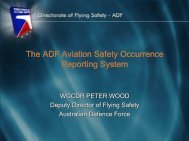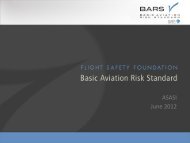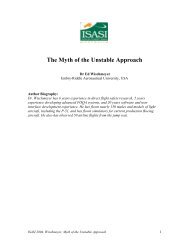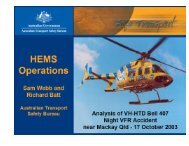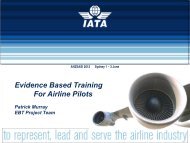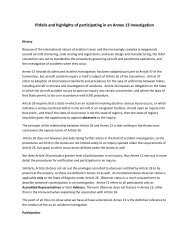communication in aviation safety: lessons learned and ... - ASASI
communication in aviation safety: lessons learned and ... - ASASI
communication in aviation safety: lessons learned and ... - ASASI
You also want an ePaper? Increase the reach of your titles
YUMPU automatically turns print PDFs into web optimized ePapers that Google loves.
March). The FAA clearly states that effective <strong>communication</strong> between all crewmembersis a prerequisite for such coord<strong>in</strong>ation (Federal Aviation Adm<strong>in</strong>istration, 1988). ASRSre<strong>in</strong>forces this po<strong>in</strong>t: “Flight attendants are an <strong>in</strong>tegral part of the aircraft crew <strong>and</strong> theirprimary responsibilities are <strong>safety</strong> related” (Callback, 2003). Rice (2001, May-June)suggests that better <strong>communication</strong> between cab<strong>in</strong> crew <strong>and</strong> flight crew have resulted <strong>in</strong>fewer fatalities. Chute <strong>and</strong> Wiener (1995) make the tie between <strong>communication</strong> <strong>and</strong><strong>safety</strong> even more explicit:There are two critical <strong>safety</strong> obligations for the flight attendant. The first is toprevent accidents, primarily by means of conveyance of <strong>in</strong>formation regard<strong>in</strong>ghazardous conditions to the flight deck. If the accident cannot be prevented, thesecond is to maximize survivability. Both roles require effective <strong>communication</strong>between the two cultures (p. 15).There are a large number of reports that confirm the success with regard to <strong>safety</strong> ofeffective <strong>communication</strong> <strong>in</strong> the cab<strong>in</strong>-cockpit <strong>in</strong>teraction (see, for example, Callback1999, August; 2003, March; 2004, February). Yet, the work<strong>in</strong>g <strong>and</strong> relationship <strong>and</strong><strong>communication</strong> <strong>in</strong>teraction between cab<strong>in</strong> crew <strong>and</strong> flight crew cont<strong>in</strong>ues to be a vex<strong>in</strong>gone. “Communication <strong>and</strong> coord<strong>in</strong>ation problems between cockpit crewmembers <strong>and</strong>flight attendants cont<strong>in</strong>ue to challenge air carriers <strong>and</strong> the FAA” (Federal AviationAdm<strong>in</strong>istration, 2004, p. 15).Helmreich, Wiener, <strong>and</strong> Kanki (1993) <strong>and</strong> Kayten (1993) cite numerous examples wherecrew coord<strong>in</strong>ation problems <strong>and</strong> poor <strong>communication</strong> were contribut<strong>in</strong>g factors <strong>in</strong> severalaccident reports. Murphy (2001) conveys stories from flight attendants who felt that vital<strong>in</strong>formation they tried to pass along to the cockpit was ignored. In their study of flightattendants <strong>and</strong> pilots, Chute & Wiener (1996) found cab<strong>in</strong>-cockpit <strong>communication</strong> to be<strong>in</strong>effective. Chute (2001) also ma<strong>in</strong>ta<strong>in</strong>s that cab<strong>in</strong>-cockpit <strong>communication</strong> is not alwaysnecessarily effective.In a report on evacuation procedures, the Transportation Safety Board of Canada (1995)<strong>in</strong>dicated that poor <strong>communication</strong> between flight <strong>and</strong> cab<strong>in</strong> crew possibly jeopardizedsafe evacuations <strong>in</strong> several <strong>in</strong>stances. Regard<strong>in</strong>g one specific <strong>in</strong>cident, the report statesthat:Inadequate <strong>communication</strong> between the cab<strong>in</strong> <strong>and</strong> the flight deck resulted <strong>in</strong> asignificant delay before the flight crew was aware of the existence <strong>and</strong> seriousnessof the fire <strong>and</strong> contributed to the fact that the evacuation was not <strong>in</strong>itiated untilone m<strong>in</strong>ute 55 seconds follow<strong>in</strong>g the rejected take-off (Transportation SafetyBoard of Canada, 1995, p. 19).Perhaps the two most dramatic examples, however, of <strong>safety</strong> problems due to poor cab<strong>in</strong>cockpitcoord<strong>in</strong>ation <strong>and</strong> <strong>communication</strong> are the crash of the Air Ontario flight whiletak<strong>in</strong>g off from Dryden, Canada on March 10, 1989 (Baker & Frost, 1994; Chute &Wiener, 1996; Merritt, 1995; Moshansky, 1992; Murphy, 2001) <strong>and</strong> the crash of theBritish Midl<strong>and</strong>s flight on January 8, 1989 at Kegworth after tak<strong>in</strong>g off from London’s17




